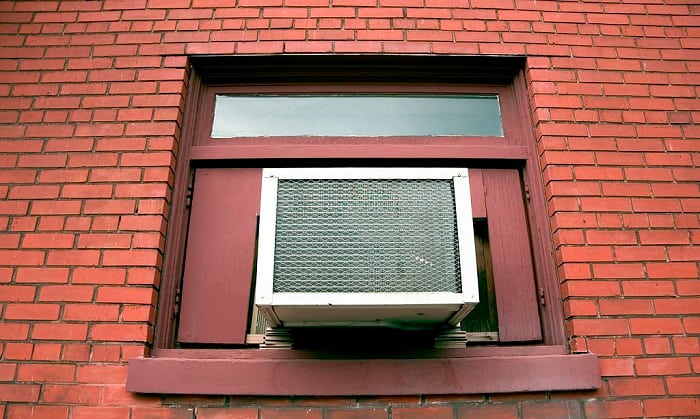Air conditioners are the perfect companion to combat the summer heat. A common design is the window air conditioner, and its installation should be up to code. Thus, its current draw is needed to properly plan your branch circuit.
How many amps does a window AC use? The current draw of this appliance can range from more than 3 amps up to around 20 amps, with starting currents higher than the running currents.
Table of Contents
Normal Window AC Amps
The current draw of a window AC depends on two factors. The first factor is the cooling capacity of the AC – expressed in British thermal units (BTU) per hour. The second factor is its energy efficiency rating or EER.
BTU is the amount of heat that can change the temperature of one pound of water by 1 degree Fahrenheit.
In AC units, the cooling capacity is the rate of how much heat the AC can transfer from inside the room to the outside, expressed in BTUs per hour. A small window AC typically has a rating of at least 5,000 BTUs, which means it can remove 5,000 BTUs of heat in the room per hour.
Another common unit of cooling capacity is the ton, which is roughly equivalent to 12,000 BTUs. A 3-ton air conditioner roughly amounts to 36,000 BTUs.
EER is the ratio between the output cooling capacity of the AC unit per hour and its input power in watts. It’s recommended to pick a model with a high EER, since said appliance needs less energy to move the same amount of heat from inside the room to the outside.
To determine the window AC unit amps, we can breakdown the definition of the EER:
\begin{equation}
\text{EER} = \frac{\text{Cooling capacity (BTU/hr)}}{\text{input power (watts)}}
\end{equation}
Power is defined as:
\begin{equation}
\text{Power (watts)} = \text{Current (amps)} \times \text{Voltage (volts)}
\end{equation}
If we substitute the definition of power to the EER formula and solve for current, we get:
\begin{equation}
\text{EER} = \frac{\text{Cooling capacity (BTU/hr)}}{\text{Current (amps)} \times \text{Voltage (volts)}}
\end{equation}
Hence, we can estimate the normal current draw of a Frigidaire FFRE123WAE 12,000 BTU air conditioner with an EER of 12 and a voltage requirement of 115 volts. The amps draw of this unit is:
\begin{equation}
\text{Current (amps)} = \frac{\text{Cooling capacity (BTU/hr)}}{\text{EER} \times \text{Voltage (volts)}} = \frac{12{,}000}{12 \times 115} = 8.70 \text{ amps}
\end{equation}
The amp draw of a unit increases as cooling capacity goes up to 15,000 BTU for the same voltage when we examine the equation. However, 15,000 BTUs is the maximum cooling capacity for a 120 volt outlet. Air conditioning units rated at 18,000 BTUs or higher, including a central air conditioner, will need 240 volts.
Furthermore, the tool enables a quick assessment of amperage
If we look at the current draw of an LG LW1817IVSM 18,000 BTU window AC at 230 volts, we can see that it has a cooling current of only 7.9 amps. This happens because the voltage increasing reduces the current draw necessary to meet the power requirement of the unit (looking at our definition of power earlier).
Take note that the above formula is only valid for EER. Similar ratings like the CEER (combined EER) take into account both the BTU rating and the standby energy consumption.
Window AC Amps on Startup
Because a window AC unit uses a motor to operate, it experiences a surge of amps at the very start that gradually lowers down until it reaches its normal amps draw. This is the starting current of an AC unit and lasts for only a short period of time.
Below is an amperage chart listing the estimated normal amps and starting amps of some window AC units:
| Cooling capacity (BTUs per hour) | Normal running current (amps) | Starting current (amps) |
| 5,000 | 4.35 | 7 to 9 |
| 6,000 | 5.22 | 8 to 11 |
| 8,000 | 6.96 | 11 to 13 |
| 10,000 | 8.70 | 13 to 16 |
| 12,000 | 10.43 | 15 to 18 |
| 14,000 | 12.17 | 17 to 21 |
| 15,000 | 13.04 | 18 to 22 |
Low Amp Window AC
A low amp air conditioner can draw as few as 4 amps. These 5,000 BTUs air conditioners are good for small rooms and have lower current draws than even portable air conditioner amps.
The lowest amp draw of these types of AC units can be as insignificant as 3.8 amps.
But portable AC use can be more beneficial for individuals who want to move their units around, in spite of the higher current draws compared to low-amp devices.
Frequently Asked Questions
How many amps do the most energy efficient window ACs use?
It depends on the cooling capacity and EER. The larger the cooling capacity in BTUs per hour, the more amps it will draw. But its efficiency depends on its EER rating, wherein the higher the EER, the less current it will require.
Can you run window AC unit on 15 amp circuit?
Yes, you can. In a 15 amp circuit, the breaker is only rated for 80% of the total circuit load, which is around 12 amps. As long as the AC unit does not draw more than that amount, it will not pose an issue.
In our previous example, the Frigidaire FFRE123WAE 12,000 BTU air conditioner can draw 8.70 amps. This is less than 12 amps, so it’s fine in a 15 amp circuit.
Conclusion
How many amps does a window AC use? The cooling capacity and EER determine the answer. A higher cooling capacity needs a higher current draw, but a higher EER signifies the device works efficiently.
Also, since the AC has a motor, its starting currents are higher than its normal running amperage.
Knowing the current draw of the air conditioner will allow for proper planning of its installation, which ensures the device is code-compliant and safe to be connected to the grid.
Read next:

I am Edwin Jones, in charge of designing content for Galvinpower. I aspire to use my experiences in marketing to create reliable and necessary information to help our readers. It has been fun to work with Andrew and apply his incredible knowledge to our content.




